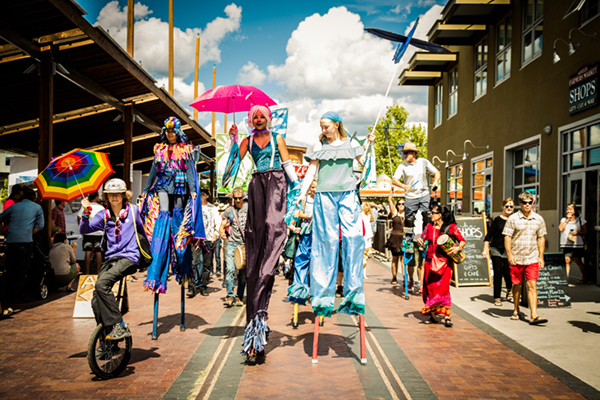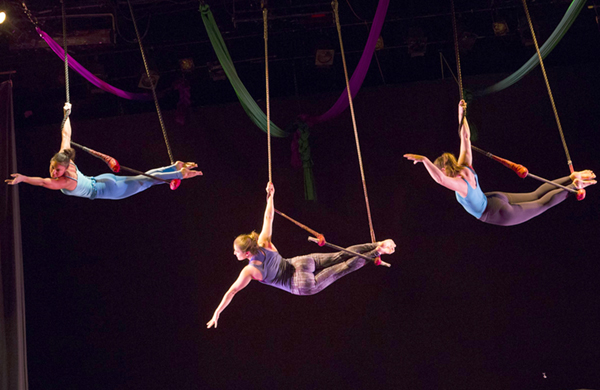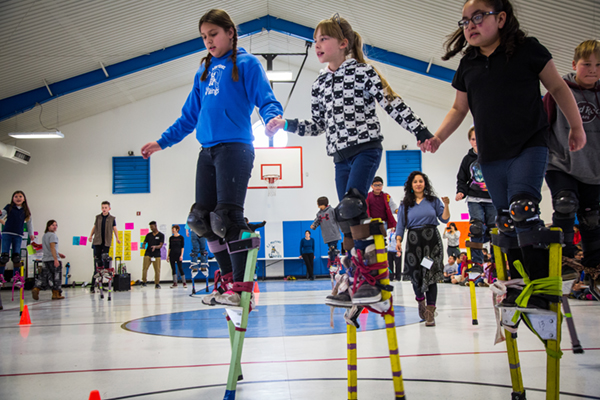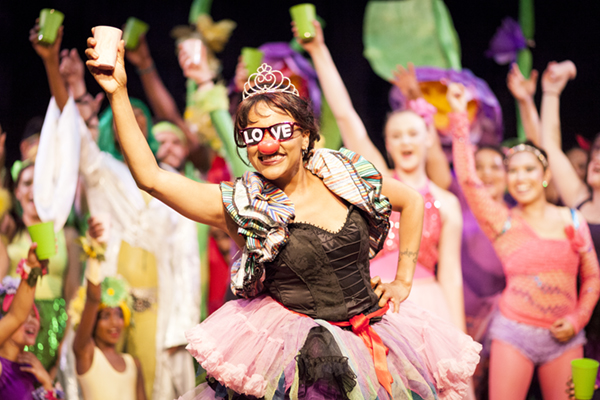The Land of Possibility
An Interview with Amy Christian
BY EMMALY WIEDERHOLT
Wise Fool is a circus arts nonprofit in Santa Fe, NM that believes in igniting imagination and promoting social justice through performances and hands-on experiences in circus, puppetry and theater. Amy Christian, artistic director and a founding member of the organization, details how circus can be a force of positive change both on the stage and in the community.
Photo by Anne Staveley
~~
How did Wise Fool get started?
Wise Fool originally started in San Francisco in the late 80s as a giant puppet street theater company doing activism around anti-nuclear testing and the First Gulf War. The concept of Wise Fool came from the idea that people can go out in the street and protest with a sign, but passersby will just keep walking with the attitude, “You think what you think, I’ll think what I think.” But if you go out in the street with a big beautiful puppet or with theater – something that’s engaging – people will come up and ask, “What is the puppet about?” or “Why are you doing this?” It breaks down walls and allows people to start a dialogue.
We started by creating big outdoor spectacles with community members by hosting workshops where people could come and share their issues. Together, we’d make a storyboard and create a show in a public space. It was a lot about creating communities where a seven-year-old boy and a 72-year-old grandmother might be making something together, crossing social barriers and getting to know each other. It was a way for people from different racial or economic backgrounds to come together in a creative and safe space and build understanding and connection.
In the late 90s, a group of us went to Chiapas, Mexico through the organization Clowns Without Borders. We made puppet and stilts performances that we took to Zapatista villages in support of the Indigenous movement. When we were putting that together, we organized from the Santa Fe area. For different personal reasons, several of us moved here.
We immediately started doing public workshops and making puppets. At that point, we started to incorporate general circus arts into what we offered. We had always done giant puppetry and stilt walking, but we started to include more aerials and acrobatics. The transition into circus was about spectacle and ways we can make our voices larger than life, as well as ways of challenging our fears and creating environments where we all have to support each other. You can’t build a pyramid unless everybody is fully invested; it’s not about the person on the top. It’s about building a strong sense of the value of each person and recognizing the potential to be lifted and lift each other. It’s about being seen and heard.
Over a big arc of time, we started a backyard circus that eventually had 500 people showing up to see a show that had been made in a horse corral. It really started as a grass roots movement. We’ve been in our own space more than 16 years now.
Photo by Gabriella Marks
For someone unfamiliar with the term ‘circus arts,’ what does it entail?
We predominantly teach aerial arts – trapeze, aerial fabric, rope, lyra hoops and invented apparatuses; acrobatics – where people build pyramids or lift each other up; manipulation arts – juggling, plate spinning, rolla bolla, walking globe; stilt walking and giant puppetry – our original forms; and clowning – our big focus now. Clowning, in particular, is really misunderstood in our country.
The image of the clown has been co-opted by horror films. The origins of that image go back to the travelling circuses who went around the country by train, the big three-ring circuses. As the circuses got more and more popular, the clowns had to create a huge image of themselves in order for the people way up in the stands to see. That’s where the rainbow wig and face paint come from. It worked for the arena, but now that’s what most people understand clowning to be. However, clowning is a very subtle form focused on connection and vulnerability. The clown exposes their vulnerability to the audience, and the audience sees themselves in the clown and realizes, “I’m not the only one who feels this way, I’m not the only one who has that awkward moment or doesn’t know how to talk to people.”
Why do circus arts and social justice go hand in hand?
The name ‘Wise Fool’ comes from European medieval times when the king or royalty had wise men to give them advice, but the wise men couldn’t necessarily say the whole truth without being axed. The fool or clown was often the person who could make light of themselves and through that bring forward issues that were maybe hard to talk about. In the climate of our world today that is heavy on political correctness and being afraid to offend someone, the fool is that person who can bring us all into the conversation in a way that opens us up and allows us to see each other’s perspectives.
In addition to the clown, the other important aspect of circus is the impossibility of what’s being done before you. When you see people do things that look impossible, it reminds you that if you put your mind to something, you can make the impossible come true. What we say at Wise Fool is: Circus is the land of all possibility. It is a place for us to discover our potential.
Circus has a revolutionary history. Travelling circuses have been used around the world as a way to remind people that social change is actually possible, even when it seems impossible, in the same way that someone standing on someone else’s head seems impossible.
Wise Fool has extensive social circus programming. Social circus is a worldwide movement, and we’re part of a national network of social circuses across the US. We use circus arts as a way for youth to build life skills like teamwork, self-respect, confidence and trust. We go into public schools throughout New Mexico to tap kids into creative self-expression and body positivity. If a kid doesn’t excel in PE, they might decide they’re not athletic, but the beauty of circus is there are many entry points. For the kid who is not physically confident, maybe they pick up juggling balls and start to build eye-hand coordination. We have tons of kids who come through our classes and don’t want to do anything physical, and all the sudden they open up through clowning. They accomplish something they never thought they could do. Circus is an empowering, non-competitive, teamwork building, physical activity that is creative and has a pathway for every unique body to be appreciated. Your body is never too big, too small, too old or too young. The circus has space for everyone.
We have an amazing program for middle school girls called Teen BUST! Middle school girls learn to trust and love their own bodies and set boundaries. We dive deep into building self esteem and confidence, that they don’t have to fit into a box. For middle school girls, that’s huge.
Social circus is a stepping stone. There might be some who go on to pursue circus professionally, but it’s all about having a positive experience and recognizing potential. Maybe the kid who got up on the trapeze and did what she thought was impossible now realizes that going to college is possible too.
Photo by Anne Staveley
How did you personally get into circus?
It took over my life; I never planned it. I had been trained as a dancer and visual artist. I was active in the anti-nuclear movement in the 80s in the Bay Area. One day I realized I was doing all these actions but not many people were paying attention. I heard of In the Heart of the Beast Theater in Minneapolis and their use of giant puppets – maybe we should try that? Instead of having an action where we have signs and get arrested, we could invite the community to something uplifting and fun. We created a festival in Livermore where the weapons lab is located. We had open workshops where anyone could come and learn to make giant puppets. At the end of the festival, we marched to the gates of the weapons lab, and the next day it was on the front page of every local newspaper. The next thing we knew, people were calling us and asking us to stilt walk and bring giant puppets to different events and causes. It combined all the things I was passionate about – I had always loved performing, I love visual arts, and I’m a real people person.
Wise Fool isn’t my thing. There have been hundreds of performers and administrators who have built it along the way. One of the beauties of the organization is that it grows and changes with the needs and desires of the community it serves.
Any other thoughts?
It’s easy for people to see us and write us off as entertainment, but what we’re doing is deep community building to make our world a better place for us all. You hear people describe the world today as a circus, especially with regards to politics. It’s not a circus. Circus is all about supporting each other, lifting each other up, and belonging. It’s the opposite of what we see happening in the world right now. Circus is what we need.
Photo by Gabriella Marks
~~
To learn more, visit wisefoolnewmexico.org.




